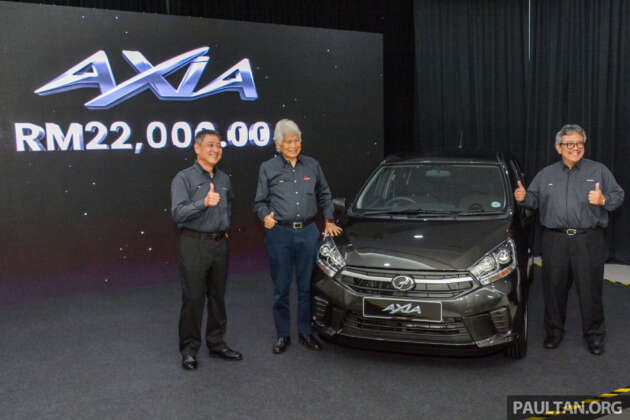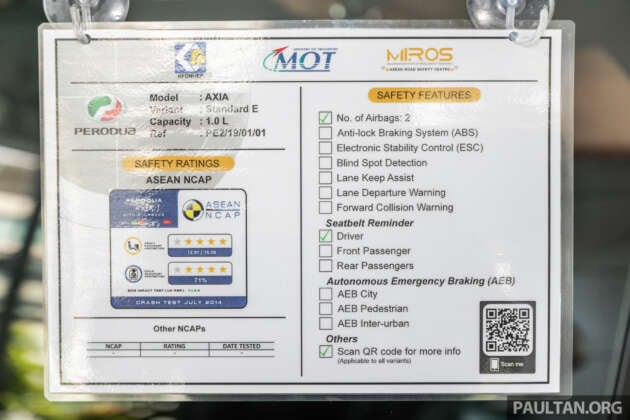MCA president and ex-transport minister Dr Wee Ka Siong has posted on his social media platforms urging carmakers to reconsider selling brands new cars without ABS (antilock braking system) and ESC (electronic stability control) in the Malaysian market, calling them minimum safety standards that should be included on all cars sold. He said these safety features should not be compromised to bring prices of cars down to ‘rahmah’ levels. He used the recently launched Perodua Axia E priced at RM22k as an example in his post.
Indeed, the Perodua Axia E does not have ABS and ESC. The only safety feature it has is two airbags. This is not just indicated on the spec sheet, but on every display car in the showroom, there will be MIROS card that lists the safety specs of the car, which will reveal this fact.
So what exactly is ABS and ESC and are they important?
Antilock Braking System (ABS)
In a car with an ABS system, there are sensors to measure each wheel’s rotation speed. Under heavy braking, if the sensors detect that any of the wheel’s rotation speed is about to lock, it will send a signal to a computer telling the brakes to relieve braking pressure on that wheel to prevent it from locking. This computerized brake pumping action can happen up to 15 times per second.
The result is a smooth and steady slowdown to a halt, shorter braking distance and maintaining steering control during heavy braking. Your braking distance will be shorter.
Electronic Stability Control (ESC)
ESC is a feature designed to improve a vehicle’s stability by detecting and reducing loss of traction (skidding). If the ESC system detects a loss of traction or skid, it can take one or more control actions to help stabilize the vehicle. These actions include selectively applying the brakes to one or more wheels, reducing the engine power, or a combination of both.
if the vehicle is understeering (not turning enough and tending to go straight), the ESC system might apply the brakes to the inside rear wheel to create a torque that helps the vehicle turn. If the vehicle is oversteering (turning too much and tending to spin out), the ESC system might apply the brakes to the outside front wheel to counteract the spin.
In some cases, the ESC system might also reduce the engine power to help regain control.
By reducing the chances of skidding or losing control, ESC systems can help drivers maintain control of their vehicle, especially in slippery conditions or when the vehicle is handling at the limit of its capabilities, thereby significantly improving safety.
Can a carmaker sell a car without ABS and ESC in Malaysia?
Malaysia previously announced that it would be making ESC mandatory on new cars from June 2018. The announcement at that time was made by transport minister Datuk Seri Liow Tiong Lai.
As far as we can tell, ABS does not seem to be mandatory for cars in Malaysia, but there are plans to make ABS mandatory for motorcycles above 150cc in Malaysia, as it is even more important to prevent crashes in motorcycles. This plan was initiated under Dr Wee Ka Siong’s tenure as transport minister.
So how can Perodua sell a car without ESC if it is mandatory? It seems that because the Axia E is an old model that was previously homologated, newer rules that mandate ESC does not apply to it.
Perodua is not alone in offering a base model without ESC. Proton’s cheapest car currently on sale which is the Proton Saga 1.3 Standard MT also does not have ESC, but it has ABS.
Why is Perodua selling a car without ABS and ESC?
The simplest explanation would be to reduce cost. At RM22k, the Axia E is even cheaper than when it was last on sale for RM 23,367. At that time, the Axia E did not have ABS or ESC either.
The cheapest Perodua Axia of its generation with ABS and ESC is the Standard G which was priced at RM33,490. That’s a full RM10k more.
What is the cheapest car in Malaysia with ABS and ESC?
Using CarBase.my’s search engine, you can set the filters to require ABS and ESC. The results sorted by cheapest car first are above. The cheapest is the 2023 Axia G priced at RM38,600. In second place is the Proton Saga 1.3 Standard AT priced at RM38,800. Next up is the 2023 Axia X priced at RM40,000.
Should Perodua add ABS and ESC to the Axia E?
At paultan.org we have always been very strong proponents of increasing the minimum safety features in our cars. We have been talking about making stability control mandatory in Malaysia for a long time and were overjoyed when it was finally made mandatory in 2018.
We have also been strong proponents of using child safety seats in cars, even giving free rental/giving away tens of thousands of ringgit worth of free child seats to low income families during festive periods in partnership with carmakers over the years.
We have since shifted our focus to advocating the inclusion of autonomous emergency braking (AEB) on cars in Malaysia, which has the potential to prevent many road accidents on the road today.
Perhaps Perodua could try to look into offering a ‘rahmah spec’ car with ABS and ESC if it is possible, perhaps an Axia EXtra alongside the E priced at RM2k higher would work? At least there will be a choice for those who value ABS and ESC without having to fork out more than RM16k for the 2023 Axia G. Perodua has used this ‘Xtra’ suffix in the past with the Axia Gxtra.
What’s the cheapest way to get an Axia with ABS/ESC then?
The cheapest way would be a used Perodua Axia Standard G spec made in September 2019 onwards. It was priced from RM33,490 when it was new. Given that Perodua offered a 5 year warranty for that generation of Axia, the first batch should still have a bit of warranty left as of June 2023.
Share your thoughts – is ABS/ESC important to you?
Will you buy a car without ABS/ESC in Malaysia? Are these safety features important to you? Share your thoughts in the comments section.
JANGAN PANDANG RINGAN SOAL KESELAMATAN ASAS KENDERAAN : Walaupun kenderaan mampu milik ditawarkan dengan harga serendah…
Posted by Wee Ka Siong on Sunday, 18 June 2023
Looking to sell your car? Sell it with Carro.




















AI-generated Summary ✨
Comments largely agree that incorporating safety features like ABS and ESC should be standard, especially in budget vehicles like the Axia E, to ensure road safety for all, including lower-income buyers. Many highlight that these features are essential and could reduce accidents, emphasizing that safety should not be compromised for cost. Several argue that it is the manufacturer's responsibility to include basic safety systems without significantly raising the price, likening it to a minimum standard for modern vehicles. Some comments mention government and regulatory roles, suggesting that safety features should be mandatory and subsidized for the poor. Others believe that responsible driving also plays a vital role, but overall sentiments favor mandatory safety inclusion for better road safety and reduced fatalities.